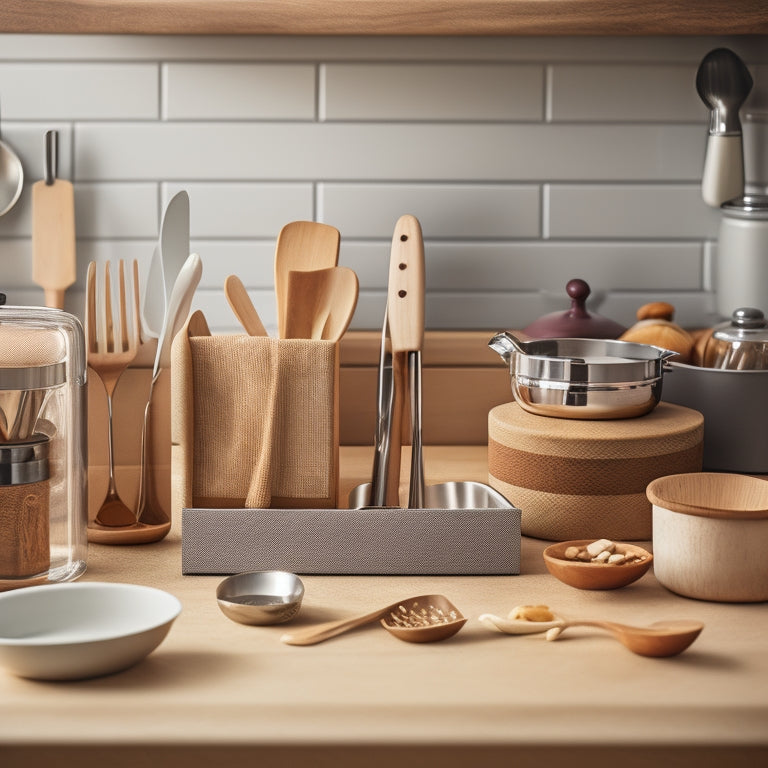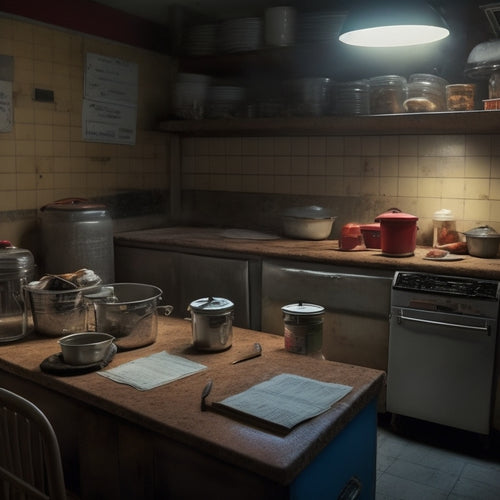
What's the Best Way to Organize Kitchen Utensils?
Share
You're about to transform your kitchen into a haven of efficiency! To get started, utilize the back of your cabinets by installing utensil holders, hooks, or pegboards. Maximize your drawer space by categorizing utensils and investing in custom inserts. Create a dedicated utensil station with a utensil crock or magnetic strip, and consider hanging frequently used items from the ceiling. By implementing these strategies, you'll be able to maintain clutter-free countertops and streamline your cooking and cleaning routine. Now, take the next step towards a more organized kitchen...
Key Takeaways
• Utilize cabinet space efficiently by installing utensil holders, hooks, or pegboards, and keeping frequently used items within easy reach.
• Maximize drawer space by implementing a utensil categorization system, dividing drawers into compartments, and prioritizing frequently used items.
• Create dedicated utensil stations by designating specific areas for frequently used utensils and using utensil crocks, magnetic strips, or organizers for storage.
• Invest in adjustable dividers to customize compartments and allocate more space to frequently used items, adjusting height and width for different utensil sizes.
• Hang utensils for easy access using sturdy ceiling hooks, utensil swivels, and pegboard systems, and group similar items together for efficient workflow.
Utilize the Back of Cabinets
Take advantage of the often-wasted space on the back of your cabinets by installing utensil holders, hooks, or a pegboard to maximize storage and keep frequently used items within easy reach. This simple yet effective solution will help you stay organized and make the most of your kitchen's real estate.
You can also add a personal touch to your cabinet doors with decorative Cabinet Decals, which come in a variety of designs and patterns to match your kitchen's style.
Additionally, consider utilizing Overdoor Storage solutions, such as hooks or baskets, to hang items like aprons, oven mitts, or even kitchen utensils. This won't only free up space inside your cabinets but also keep your kitchen countertops clutter-free.
Maximize Drawer Space Efficiently
Now that you've optimized your cabinet space, it's time to turn your attention to your kitchen drawers.
To make the most of this valuable real estate, you'll want to implement a few key strategies that'll keep your utensils organized and within easy reach.
Utensil Categorization System
You'll find that grouping your kitchen utensils into categories helps you allocate your drawer space more efficiently. This is because categorization allows you to prioritize your utensils based on their frequency of use and importance.
For instance, you can create a category for your Utensil Priorities, such as essential items like knives, cutting boards, and spatulas. This way, you can guarantee that these crucial tools are easily accessible and take up prime real estate in your drawer.
Next, assign Category Labels to each group, making it easy to identify where each utensil belongs. For example, you might've labels for Baking, Cooking, or Serving. This system enables you to visualize your utensils and their relationships, making it simpler to store and retrieve them.
Divided Drawer Compartments
With your utensil categorization system in place, dividing your drawer into compartments tailored to each category guarantees that every item has a designated home, freeing up space and reducing clutter.
This is where compartmentalization comes in – the process of dividing your drawer into separate sections, each designed to hold specific utensils. By doing so, you'll be able to find what you need quickly and easily, without having to dig through a jumbled mess.
To take your compartmentalization to the next level, consider investing in custom inserts. These are specifically designed to fit your drawer and utensil categories, ensuring a perfect fit and maximizing storage space. You can find custom inserts in various materials, such as wood, plastic, or silicone, and they can be tailored to fit your specific needs.
Optimize Utensil Placement
How can you guarantee that each utensil is placed in its designated compartment in a way that maximizes your drawer's storage capacity? To achieve this, you need to optimize utensil placement by creating a harmonious Utensil Flow. This means arranging your utensils in a way that allows you to access what you need quickly and efficiently.
Here are some tips to help you achieve Utensil Flow:
-
Zone Clustering: Group similar utensils together, such as all your baking utensils or cooking utensils, to create zones within your drawer.
-
Prioritize frequently used items: Place your most frequently used utensils in easy-to-reach locations, saving you time and effort.
-
Store utensils by size: Organize utensils from largest to smallest to make sure that each one fits snugly in its designated compartment.
- Leave breathing room: Don't overcrowd your compartments; leave a little space between each utensil to prevent scratching and tangling.
Create a Utensil Station
When setting up a utensil station, you'll want to contemplate placement ideas that make sense for your kitchen workflow.
You'll need to determine which tools will go in a designated drawer and how to maximize the counter space around your station.
Utensil Placement Ideas
Create a utensil station by designating a specific area of your kitchen counter or wall as a central hub for frequently used utensils, keeping them organized and within easy reach. This strategic placement will streamline your kitchen workflow optimization and make cooking a breeze.
Here are some utensil placement ideas to get you started:
-
Utensil crock: Place a decorative crock near your cooking station to store frequently used utensils like spoons, spatulas, and whisks.
-
Magnetic strip: Install a magnetic strip on your countertop or wall to hang lightweight utensils like tongs, scissors, and knives.
-
Utensil organizer: Use a utensil organizer with separate compartments to store and categorize your utensils, making it easy to find what you need when you need it.
- Over-the-sink shelf: Install an over-the-sink shelf to store utensils like colanders, strainers, and scrubbers, keeping them organized and out of the way.
Tool Drawer Organization
Transform your kitchen's tool drawer into a utensil station by allocating specific zones for each type of utensil, ensuring everything has its designated place and is easily accessible. This will save you time and frustration when searching for the right tool. Start by categorizing your utensils into groups, such as baking, cooking, and serving. Then, assign a specific zone in the drawer for each group.
Consider investing in soft close drawers to prevent loud noises and scratches. To maximize storage, use custom inserts that fit your utensils perfectly. These inserts can be adjustable or fixed, depending on your needs. You can also use dividers or small containers to separate and organize smaller items like spices, oils, or condiments. Label each zone and insert so you can quickly identify where everything is.
Counter Space Maximization
You can reclaim valuable counter space by designing a utensil station that keeps frequently used items within easy reach, freeing up room for food preparation and cooking. This thoughtful organization won't only reduce clutter but also enhance your kitchen's aesthetics.
By allocating a specific area for your utensils, you'll avoid corner clutter and create a sense of harmony in your kitchen.
Here are some essentials to include in your utensil station:
-
Utensil Holder: A container or tray to hold your most frequently used items, such as spatulas, whisks, and tongs.
-
Knife Block: A designated spot for your knives, keeping them organized and within reach.
-
Spice Rack: A compact rack to store your essential spices, oils, or condiments.
- Countertop Canister: A decorative canister to store dry goods like flour, sugar, or coffee.
Invest in Adjustable Dividers
Adjustable dividers prove to be a game-changer in kitchen utensil organization. They can be easily customized to fit your unique storage needs. By investing in adjustable dividers, you can create customizable compartments that cater to your specific utensil collection. This means you can allocate more space to frequently used items and less space to those that are used less often.
When it comes to flexible shelving, adjustable dividers are a dream come true. You can adjust the height and width of each compartment to accommodate different sizes of utensils, from large serving spoons to small whisks. This flexibility allows you to make the most of your kitchen storage space, ensuring that every utensil has its designated place.
With adjustable dividers, you can say goodbye to cluttered kitchen drawers and hello to a more organized, stress-free cooking experience. By tailoring your storage space to your specific needs, you'll be able to find what you need quickly and easily, making meal prep a breeze.
Hang Utensils From Ceiling
Maximizing vertical space, hanging utensils from the ceiling is a clever way to free up valuable kitchen real estate while keeping frequently used items within easy reach. By doing so, you'll create a sense of openness and airflow in your kitchen, making it feel more spacious and inviting.
Here are some benefits to take into account:
-
Easy access: Hang your most frequently used utensils, like pots, pans, and colanders, within easy reach to save time and effort.
-
Ceiling Hooks: Use sturdy ceiling hooks that can hold a decent amount of weight to make sure your utensils are securely in place.
-
Utensil Swivel: Invest in an utensil swivel that allows you to easily rotate and access your utensils without having to climb up and down a ladder.
- Visual appeal: Hanging utensils from the ceiling adds a touch of industrial chic to your kitchen, making it a conversation starter when entertaining guests.
Designate a Utensil Zone
By consolidating utensils into a designated zone, you'll create a functional hub that complements your ceiling-hung utensils and streamlines kitchen workflow. This zone will become the heart of your kitchen, where you can easily access and store your most frequently used utensils.
To make the most of this zone, consider your Utensil Personality - do you prefer a minimalist setup or a more elaborate arrangement? This will help you determine the layout and storage solutions that work best for you.
To maintain order and visual appeal, add Zone Signage to categorize and label your utensils. This can be as simple as using adhesive labels or as decorative as a chalkboard sign. By designating specific areas for specific utensils, you'll reduce clutter and make cooking and cleaning more efficient.
With a well-organized utensil zone, you'll feel more in control and connected to your kitchen space, making meal prep and cooking a more enjoyable experience.
Store Less Frequently Used Items
Now that you've optimized your utensil zone for frequently used items, turn your attention to storing less frequently used items, such as special occasion gadgets or infrequently needed tools, in a designated area that's still accessible but out of the way. This will help maintain a clutter-free kitchen while keeping these items within reach when you need them.
Consider the following storage options for less frequently used items:
-
Garage Storage: Utilize garage storage bins or shelves to store items like turkey fryers, slow cookers, or other bulky kitchen gadgets.
-
Attic Organization: Take advantage of attic storage for items like cookie cutters, cake pans, or other seasonal kitchen tools.
-
Upper Cabinets: Allocate a section of your upper cabinets for less frequently used items, making sure they're still accessible but not taking up prime real estate.
- Under-Bed Storage: Use under-bed storage containers to store items like pastry brushes, silicone mats, or other kitchen accessories that you don't need immediate access to.
Implement a Pegboard System
You can create a highly functional and efficient storage space for your frequently used utensils by implementing a pegboard system in your kitchen. This system allows you to hang your utensils, tools, and accessories on a board, freeing up valuable counter and cabinet space.
To get started, plan your pegboard layout by grouping similar items together, such as cooking utensils, baking tools, and cleaning supplies. Consider the frequency of use and the size of each item when determining the layout.
Next, customize your pegboard by adding hooks, bins, and holders that fit your specific needs. You can find a wide range of pegboard accessories online or in home improvement stores. For example, add a bin for storing small items like spices or oils, or use hooks to hang your most frequently used utensils.
With a pegboard system, you'll be able to quickly find what you need, reducing clutter and stress in the kitchen. By investing a little time and effort into designing your pegboard, you'll be rewarded with a more organized, efficient, and enjoyable cooking experience.
Optimize Corner Cabinet Space
Corner cabinet space can be notoriously difficult to navigate, but with a few strategic adjustments, this often-wasted area can become a valuable storage hub.
You can maximize this space by installing corner shelves that provide easy access to your kitchen utensils. These shelves can be adjustable, allowing you to customize the storage to fit your specific needs.
Here are some additional ways to optimize your corner cabinet space:
-
Install a Cabinet Carousel: A carousel allows you to store more items in the corner cabinet while making it easy to retrieve them.
-
Use a Lazy Susan: A Lazy Susan is a great way to store small items like spices or oils, making them easily accessible.
-
Add a Pull-Out Basket: A pull-out basket can be installed in the corner cabinet to store items like kitchen towels or cleaning supplies.
- Utilize the Back of the Cabinet Door: You can attach a storage rack or a magnetic board to the back of the cabinet door to store additional items, such as utensils or recipe cards.
Frequently Asked Questions
How Often Should I Clean and Maintain My Utensil Organization System?
'When you're on a roll, keep the momentum going! Schedule cleanings every 1-2 months to maintain your utensil organization system, and implement utensil rotation to guarantee everything gets used and stays in top condition.'
Can I Use Adhesive Hooks on My Kitchen Cabinets and Walls?
You can use adhesive hooks on your kitchen cabinets and walls, but consider the hook placement and cabinet material first; for instance, avoid placing hooks near heat sources or on delicate surfaces, and choose hooks suitable for your cabinet's material, like wood or metal.
Are There Any Specific Utensil Organization Systems for Small Kitchens?
You'll love maximizing your small kitchen's potential with space-saving utensil organizers, like corner optimizers that turn dead space into functional storage, and adjustable dividers that keep countertops clutter-free and your favorite tools within easy reach.
How Do I Organize Utensils With Long Handles, Like Spoons and Spatulas?
"Like a conductor leading an orchestra, you'll harmonize your kitchen with long-handled utensils by utilizing handle holders and countertop containers, keeping them upright and within reach, making cooking a symphony of efficiency."
Can I Repurpose Old Kitchen Items as Utensil Organizers?
You can breathe new life into old kitchen items by repurposing them as utensil organizers. For instance, use Mason jars or vintage containers to store utensils, creating a charming and functional organizer that adds character to your kitchen.
Related Posts
-

Affordable Amazon Home Improvement Must-Haves
You're one step away from a more organized, stylish, and functional living space! Start with must-haves like mDesign'...
-

Food Safety Inspections Uncover Startling Violations
Food safety inspections in local establishments have uncovered a disturbingly high number of critical violations, put...

